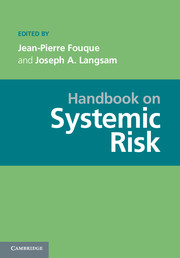Book contents
- Frontmatter
- Contents
- Contributors
- Introduction
- PART I DATA: THE PREREQUISITE FOR MANAGING SYSTEMIC RISK
- PART II STATISTICS AND SYSTEMIC RISK
- PART III MEASURING AND REGULATING SYSTEMIC RISK
- PART IV NETWORKS
- PART V SYSTEMIC RISK ANDMATHEMATICAL FINANCE
- PART VI COUNTERPARTY RISK AND SYSTEMIC RISK
- PART VII ALGORITHMIC TRADING
- PART VIII BEHAVIORAL FINANCE: THE PSYCHOLOGICAL DIMENSION OF SYSTEMIC RISK
- PART IX REGULATION
- PART X COMPUTATIONAL ISSUES AND REQUIREMENTS
- PART XI ACCOUNTING ISSUES
PART III - MEASURING AND REGULATING SYSTEMIC RISK
Published online by Cambridge University Press: 05 June 2013
- Frontmatter
- Contents
- Contributors
- Introduction
- PART I DATA: THE PREREQUISITE FOR MANAGING SYSTEMIC RISK
- PART II STATISTICS AND SYSTEMIC RISK
- PART III MEASURING AND REGULATING SYSTEMIC RISK
- PART IV NETWORKS
- PART V SYSTEMIC RISK ANDMATHEMATICAL FINANCE
- PART VI COUNTERPARTY RISK AND SYSTEMIC RISK
- PART VII ALGORITHMIC TRADING
- PART VIII BEHAVIORAL FINANCE: THE PSYCHOLOGICAL DIMENSION OF SYSTEMIC RISK
- PART IX REGULATION
- PART X COMPUTATIONAL ISSUES AND REQUIREMENTS
- PART XI ACCOUNTING ISSUES
Summary
Measuring and Regulating Systemic Risk
This Part comprises three chapters on the important issue of measuring and regulating systemic risk. The Dodd–Frank Act in the United States requires that the Financial Stability Oversight Council (FSOC) designate a set of institutions in the financial sector as “systemically important financial institutions” (SIFIs). The Financial Stability Board at the Bank for International Settlements (BIS) has a similar task of designating a list of Global SIFIs. In Europe, the ongoing sovereign crisis has also highlighted that key roots of systemic risk linked to bank holdings of risky Eurozone sovereign debt remained unchecked and unattended by existing bank capital requirements. This section offers some ways to measure systemic risk in a more efficient and relevant way than bank regulation has done hitherto, and also how to use these measures to design prudential bank regulation.
The first chapter, Measuring Systemic Risk, by Viral Acharya, Christian Brownlees, Robert Engle, Farhang Farazmand and Matthew Richardson describes various approaches to measuring systemic risk. The authors present a methodology that has been employed in the NYU–Stern Systemic Risk Rankings for measuring the contribution of a financial firm to systemic risk. The proposed measure captures the capital shortfall of a financial firm relative to a desired capitalization in an aggregate stress scenario, and can be computed using readily available market data such as stock market returns (to estimate the downside exposure of a financial firm to the risk of an aggregate crisis) and leverage (assets-to-equity) ratio of the firm.
- Type
- Chapter
- Information
- Handbook on Systemic Risk , pp. 191 - 195Publisher: Cambridge University PressPrint publication year: 2013



